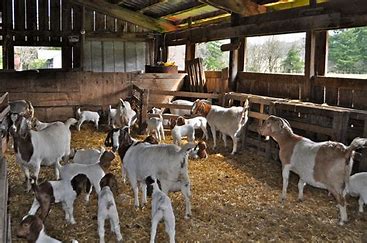

We all want to live in peace. They have evolved a social system to avoid conflict. Problems occur when considering how to house goats. Housing design might conflict with their natural social inclinations. That is when you see them fight.
Goats naturally compete when feed and resources are centralized, because they evolved in regions where food, water, mates, and shelter were hard to find. A strict hierarchy is set up to rule who gets first choice without resorting to conflict. Subordinates are expected to keep their distance, which is easy to do out in the open, but trickier when housing goats in barns. Issues occur when space is restricted and escape routes are blocked. Subordinates cannot get out of the way at a rate that the head goat finds acceptable.
Therefore one needs to bear housing design in mind as part of routine care of goats. Firstly, the walls may not allow sufficient space for subordinates to escape fast enough or far enough away. Secondly, feed may be dispensed centrally, meaning that subordinates cannot access the feed without transgressing dominants’ personal space. Thirdly, the custom of introducing new stock and selling off excess animals is contrary to does’ natural social system of stable family groups.
Keeping Companions Together
When new goats are introduced to an established herd for example along with two familiar goats, they are normally found to suffer less stress and each received less aggression than one goat introduced alone. Researchers also recommended making introductions in a large arena at pasture, where they have space to settle their hierarchy and still find access to forage.
How Much Space Do Goats Need?
Goats that had grown up together would feed side by side at distances of one to five feet (0.5–1.5 m), whereas those regrouped as adults fed at greater distances up to thirteen feet (0.5–4 m). Overall, it is recommended to keep goat groups stable and consisting of companions that have grown up together.
Even when goats are bonded, competition will naturally arise. Apart from spreading out our feeding racks to give each goat a chance to feed, the trials revealed other effective measures that we can take where space is limited. Building solid partitions between feeding stations allowed subordinate goats to feed closer to more dominant goats, as did feeding at different heights. Partitions 43 inches (110 cm) long and platforms 32 inches (80 cm) high worked best for horned goats and goats grouped when they were adults. Solid partitions allowed subordinate goats to remain out of sight of dominants while feeding. Platforms were also used by the subordinate members to avoid aggression. These measures appear to satisfy the dominants’ need for personal space.
However, goats with stronger bonds, such as those that grew up together, needed greater visual contact afforded by shorter or partially see-through barriers.
 Contact Jaguza Support
Contact Jaguza Support